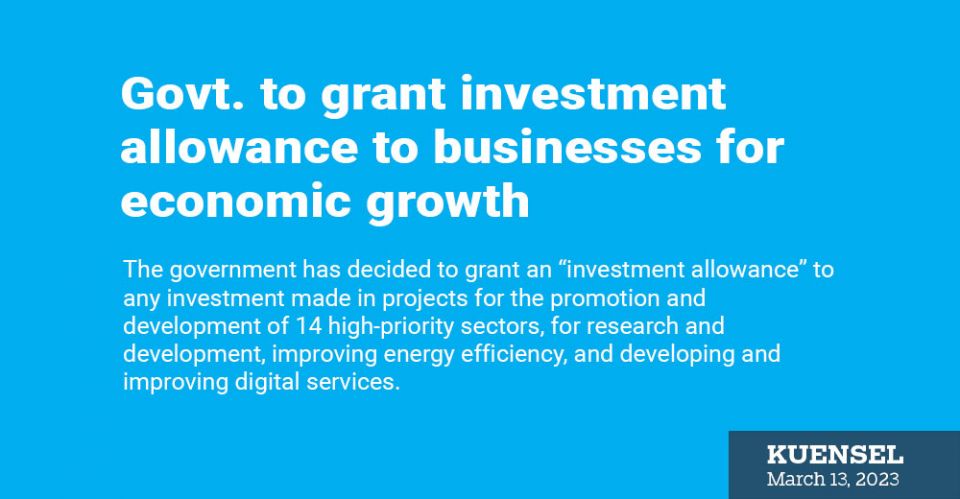
The government has decided to grant an “investment allowance” to any investment made in projects for the promotion and development of 14 high-priority sectors, for research and development, improving energy efficiency, and developing and improving digital services.
An investment allowance is a type of tax break that is extended to companies as a means of motivating the companies to invest in various ventures.
The idea is that by providing some sort of tax incentive, the activity will grow capital investment within the economy that ultimately will benefit all the players in the economy.
The finance ministry issued guidelines on investment allowance slabs and treatment of investment allowance under part I, chapter 3 of the Fiscal Incentives Act of Bhutan 2021 on March 7.
According to the ministry, the guidelines will provide clarity and transparency in the government’s investment policy and the incentives available to investors.
The 14 high-priority sectors are agriculture and renewable natural resources, business infrastructure development, construction, cooperatives, creative industry, cottage and small industries, education, energy excluding hydroelectric projects, health, ICT excluding telecommunications, manufacturing, mining, tourism, transport, and waste management and recycling industries.
Finance Minister Namgay Tshering notified that the investment allowance slab would help promote investment in various economic sectors, leading to increased economic activity, job creation, and ultimately, economic growth.
The treatment guidelines are expected to help ensure that investments are directed towards sectors that are critical to the development of the country, he added.
Under the investment allowance slab, investments up to Nu 5 million (M) would be eligible for a 100 percent investment allowance on a project’s fixed capital expenditure.
Investments ranging from Nu 5M to Nu 10M would be eligible for an investment allowance of 50 percent of the amount exceeding Nu 5M over and above lump sum amount of Nu 5M.
The maximum allowance would be limited to Nu 7.5M if the investment incurred is a maximum of Nu 10M.
The investment ranging from Nu 10M to Nu 40M would be eligible for an investment allowance of 25 percent of the amount exceeding Nu 10M over and above lump sum amount of Nu 7.5M. The maximum allowance shall be limited to Nu 15M if the investment incurred is to the maximum of Nu 40M.
The investment over and above Nu 40M would be eligible for an investment allowance of 5 percent of the amount exceeding Nu 40M over and above lump sum amount of Nu 15M. There would not be any maximum allowance if the investment hits beyond Nu 40M.
However, no investment allowance will be granted if any project has been granted direct tax incentives.
The full amount of investment allowance granted would be a deductible expenditure in the income year in which the capital expenditure is incurred, after the deduction of all expenses, depreciation, and carry-forward losses allowed under the Income Tax Act of Bhutan 2001.
Any investment that is not deducted in an income year because the business does not have “sufficient profits” in the income year would be carried forward as losses and deductible in the subsequent income years.












